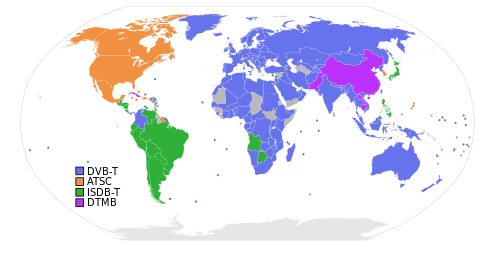Advanced Television Systems Committee
Advanced Television Systems Committee ( ATSC for short ) is an American organization that sets standards for digital television . It was founded in 1982 as part of the Advanced Television Committee and is based in Washington, DC
The standards of the ATSC include specifications for high-definition digital television ( HDTV ), EDTV and poor quality standard digital television ( SDTV ).
Standards
The ATSC standard is intended to replace the American NTSC television system. The HDTV standards under the umbrella of the ATSC standard reproduce 16: 9 images with a maximum resolution of 1920 × 1080 pixels, which is almost six times higher than the old NTSC standard (640 × 480/720 × 486). However, there are many more resolutions listed in this standard. Six SDTV channels, or one HDTV channel and four SDTV channels, can be transmitted on a 6 MHz wide television channel.
ATSC is the North American counterpart to the DVB-T standard. All major metropolises in America have meanwhile switched to ATSC, but the analogue broadcasting systems continue to broadcast in simulcast mode , since the poorer sections of the population, who make up the majority of terrestrial viewers, do not want to switch off the television signal overnight. NTSC analog television broadcasts were due to cease on February 17, 2009. With the DTV Delay Act , which came into force on February 11, 2009 , the date was postponed to June 12, 2009. This only applies to terrestrial transmissions. Cable and satellite transmissions are not affected by this measure.
Modulation method
The ATSC standard uses the following profiles:
- 8-VSB : 19.39 Mbit / s (terrestrial) 6 MHz bandwidth .
- 16-VSB : 38.78 Mbit / s (cable) 6 MHz bandwidth.
Refresh rates
Depending on the quality, the frame rate varies between 24 frames (SDTV) and 60 frames per second (HDTV).
| 640 × 480 (4: 3 SDTV) interlaced | 29.97 (59.94 frames / s) | 30 (60 fps) progressive | 23.976 | 24 | 29.97 | 30th | 59.94 | 60 |
| 704 × 480 (4: 3 or 16: 9 SDTV) interlaced | 29.97 (59.94 frames / s) | 30 (60 fps) progressive | 23.976 | 24 | 29.97 | 30th | 59.94 | 60 |
| 720 × 480 (4: 3 or 16: 9 SDTV) interlaced | 29.97 (59.94 frames / s) | 30 (60 fps) progressive | 23.976 | 24 | 29.97 | 30th | 59.94 | 60 |
| 1280 × 720 (16: 9 HDTV) progressive | 23.976 | 24 | 29.97 | 30th | 59.94 | 60 | ||
| 1920 × 1080 (16: 9 HDTV) interlaced | 29.97 (59.94 frames / s) | 30 (60 fps) progressive | 23.976 | 24 | 29.97 | 30th |
Image formats
The following image formats are supported:
- 480i60, 480p30 (NTSC)
- 480p60
Web links
- official homepage
- The standardized ATSC formats at a glance
- FCC.gov site with information about the conversion (English)
Footnotes
- ↑ DTV Delay Act: http://thomas.loc.gov/cgi-bin/bdquery/z?d111:SN00352:@@@X

